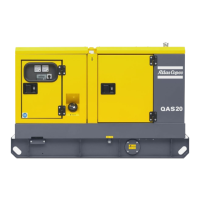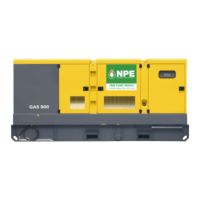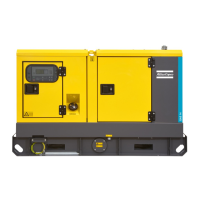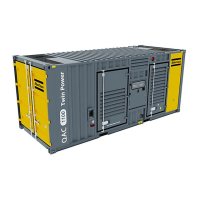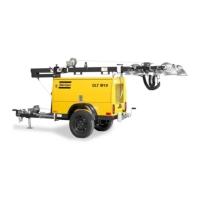Instruction Manual
2954 9020 00 13
3.2 Connecting the generator
3.2.1 Precautions for non-linear and sensitive
loads
The most common non-linear, 3-phase loads are thyristor/rectifier-
controlled loads, such as convertors supplying voltage to variable
speed motors, uninterruptable power supplies and Telecom sup-
plies. Gas-discharge lighting arranged in single-phase circuits gen-
erate high 3rd harmonics and risk for excessive neutral current.
Loads most sensitive to voltage distortion include incandescent
lamps, discharge lamps, computers, X-ray equipment, audio ampli-
fiers and elevators.
Consult Atlas Copco for measures against the adverse influence of
non-linear loads.
3.2.2 Quality, minimum section and maximum
length of cables
The cable connected to the terminal board of the generator must be
selected in accordance with local legislation. The type of cable, its
rated voltage and current carrying capacity are determined by in-
stallation conditions, stress and ambient temperature. For flexible
wiring, rubber-sheathed, flexible core conductors must be used.
3.2.3 Connecting the load
Site distribution panel
If outlet sockets are required, they must be mounted on a site distri-
bution panel supplied from the terminal board of the generator and
in compliance with local regulations for power installations on
building sites.
Protection
– Check whether frequency, voltage and current comply with the rat-
ings of the generator.
– Provide for the load cable, without excessive length, and lay it out
in a safe way without forming coils.
– Open the door of the control and indicator panel and the transparent
door in front of the terminal board X1.
– Provide the wire ends with cable lugs suited for the cable terminals.
– Loosen the cable clamp and push the wire ends of the load cable
through the orifice and clamp.
– Connect the wires to the proper terminals (L1, L2, L3, N and PE) of
X1 and tighten the bolts securely.
– Tighten the cable clamp.
– Close the transparent door in front of X1.
3.3 Before starting
– With the generator standing level, check the engine oil level and top
up if necessary. The oil level must be near to, but not exceed the
high mark on the engine oil level dipstick.
– Check the coolant level in the expansion tank of the engine cooling
system. The water level must be near to the FULL mark. Add cool-
ant if necessary.
– Drain any water and sediment from the fuel pre-filter. Check the
fuel level and top up if necessary. It is recommended to fill the tank
after the day’s operation to prevent watervapor in a nearly empty
tank from condensing.
– Check the vacuum indicator of the air filter. If the red part shows
completely, replace the filter element.
– Press the vacuator valve of the air filter to remove dust.
– Check the generator for leakage, tightness of wire terminals, etc.
Correct if necessary.
– Check that fuse F4 is not activated and that the emergency stop is in
the “OUT” position.
– Check that the load is switched off.
– Check that circuit breakers Q1.1 and Q1.2 are switched off.
– Check the correct position of the voltage selector switch (S10) on
the alternator.
Non-linear loads draw currents with high contents
in harmonics, causing distortion in the wave form of
the voltage generated by the alternator.

